Economy

Continued Recovery in Manufacturing Indicators
Written by Brett Linton
March 3, 2021
U.S. industrial production, manufacturing and durable goods orders through January and February data continued to show improvement from the coronavirus pandemic downturn. The health of the manufacturing economy has a direct bearing on the health of the steel industry.
![]() The Industrial Production Index
The Industrial Production Index
The IP index is a gauge of output from factories, mines and utilities. Industrial production took a serious hit from the shutdowns of nonessential businesses and other measures mandated by the government in the first and second quarters of 2020 to stem the spread of the coronavirus. Figure 1 shows the three-month moving average (3MMA) of the IP index since January 2007 as the black line and the year-over-year change in orange. From March through June, the 3MMA of the IP index dropped by 14 percent, from 107.7 down to 93.7. The 3MMA has recovered each month since July, up to 106.1 in January. (Note, the 3MMA smooths out monthly variability.)
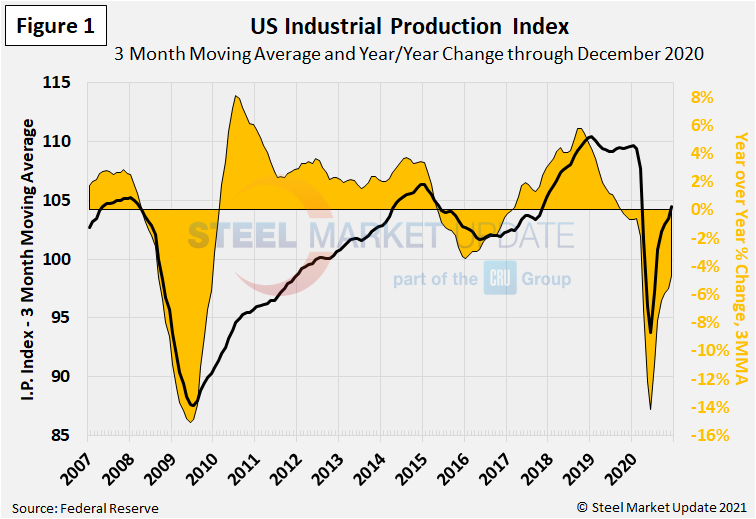
Manufacturing Capacity Utilization
Manufacturing capacity utilization rose for the seventh consecutive month, now measured at 73.9 percent as a 3MMA through January, and remains outside of recessionary territory for the third month. The rate had hovered around 75 percent for most of the 2010’s, but began to decline in March 2020 and reached a low of 63 percent in June 2020 (Figure 2).
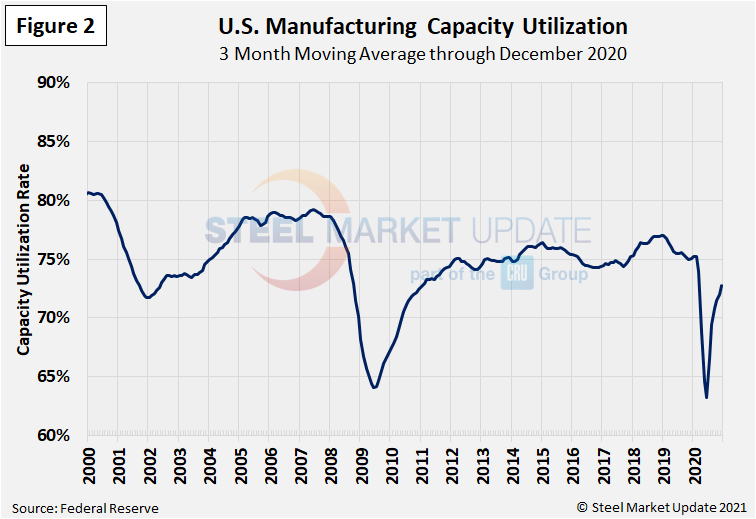
New Orders for Durable Goods
New orders for durable goods, an early indicator of consumer and business demand for U.S. manufactured goods, have essentially recovered from the virus shock last year (Figure 3). The 3MMA dropped by more than 23 percent from February through May, from a peak of $246.4 billion to a low of $188.5 billion. New orders increased to $249.9 billion as a 3MMA through January 2021, now at a 21-month high and very positive news for the economy.
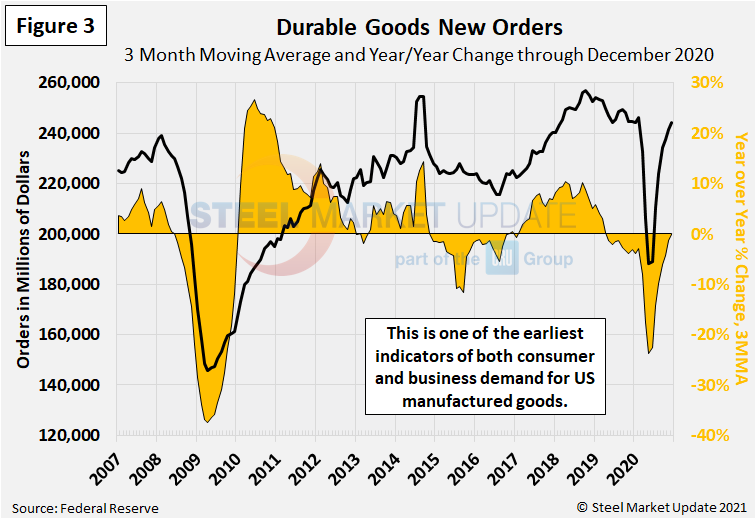
New Orders for Manufactured Products
The growth rate of new orders for manufactured products as reported by the Census Bureau was slightly negative for most of 2019, then declined sharply in March 2020 (Figure 4). On a 3MMA basis, factory orders fell to a near 10-year low in June at $410.7 billion. Factory orders in December 2020 were down just 1 percent year-over-year to $488.0 billion, the smallest (negative) annual rate of change since February 2020.
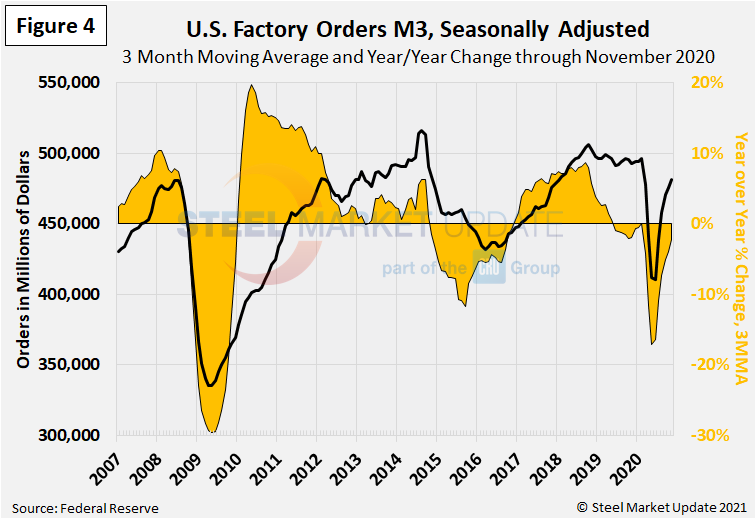
New Orders for Products Manufactured from Iron and Steel
Within the Census Bureau M3 manufacturing survey is a subsection for iron and steel products. Figure 5 shows the history of new orders for iron and steel products since January 2000 as a 3MMA. The 3MMA year-over-year growth rate, which reached negative 20.0 percent last May, rebounded to positive 2.6 percent in December at $10.2 billion.
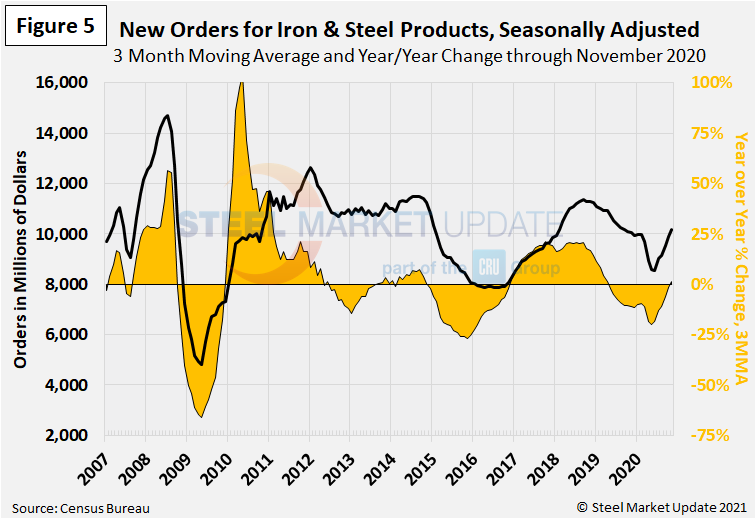
Inventories of Products Manufactured from Iron and Steel
Inventories of iron and steel products broke their multi-month decline streak in December, rising slightly from the month prior. The latest iron and steel inventory levels totaled $18.3 billion on a 3MMA basis, down 7.9% compared to the same period the year prior (Figure 6). The fact that new orders for manufactured goods were up while inventories of manufactured goods were down may reflect the tight availability and rising price of steel late last year.
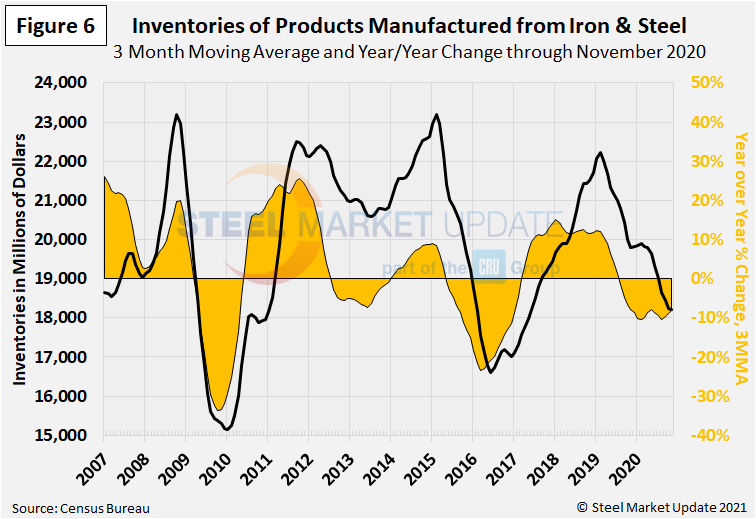
The ISM Manufacturing Index
The Institute for Supply Management’s Manufacturing Index is a diffusion index. An index value above 50 indicates that the manufacturing economy is expanding. As Figure 7 shows, the index on a 3MMA basis remained in contraction territory from September 2019 through June 2020, but has recovered each month since then. The ISM index as a 3MMA now stands at 60.0 in February, surpassing the previous high in August 2018 and now pushing against the April 2011 high of 61.0. For comparison, the record high 3MMA was 62.4 in March 2004.
“Manufacturing performed well for the ninth straight month, with demand, consumption and inputs registering strong growth compared to January. Labor-market difficulties at panelists’ companies and their suppliers continued to restrict manufacturing-economy expansion and will remain the primary headwind to production growth until employment levels and factory operations can return to normal across the entire supply chain,” said ISM Business Survey Committee Chairman Timothy Fiore.
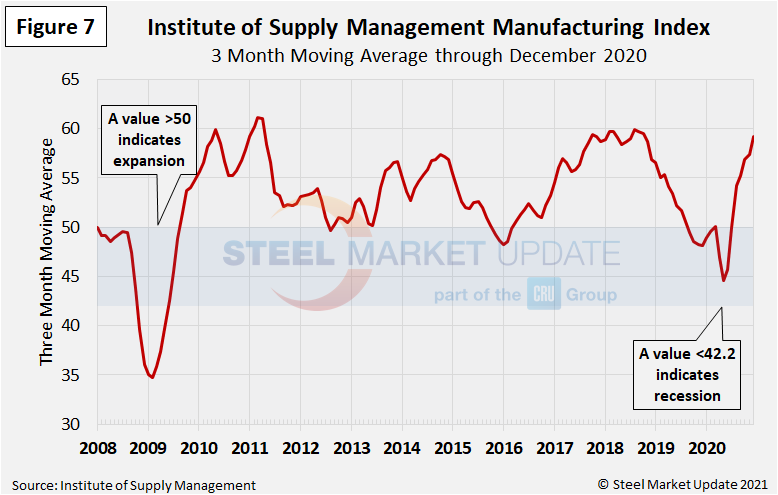
By Brett Linton, Brett@SteelMarketUpdate.com

Brett Linton
Read more from Brett LintonLatest in Economy

AISI: Raw steel production ticks up near recent high
The volume of raw steel produced by US mills inched higher last week, according to the American Iron and Steel Institute (AISI). After steadily increasing in April and May, domestic mill output stabilized in early June and has remained historically strong since.

Steel groups welcome passage of budget bill
Steel trade groups praised the passage of the Big Beautiful Bill (BBB) in Congress on Thursday.

Industry groups praise Senate for passing tax and budget bill
The Steel Manufacturers Association and the American Iron and Steel Institute applauded the tax provisions included in the Senate's tax and budget reconciliation bill.

Chicago PMI dips 0.1 points in June
The Chicago Purchasing Managers Index (PMI) slipped 0.1 points to 40.4 points, in June.

Multi-family pullback drives housing starts to 5-year low in May
US housing starts tumbled in May to a five-year low, according to figures recently released by the US Census Bureau.
